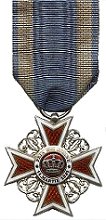Romania Awards and Decorations
The following Romanian awards were made to soldiers of the Worcestershire Regiment for gallantry or meritorious service. They are recorded in the London Gazette, indicating the granting of the award or decoration by the sovereign of Romania, and intimating the British sovereigns permission for it to be accepted and worn by the recipient.
|
|
|
|
|
Order of the Star (Chevalier) (Knight) |
Order Of the Crown (Officer) |
Order Of the Crown (Chevalier) (Knight) |
Medalia Barbatie si Credinta (1st Class) |
Medalia Barbatie si Credinta (2nd Class) |
Order of the Star of Romania (Ordinul Steaua Romaniei) 1877-1947
The Order of the Star was the first Order instituted by the country of Romania after it became an independent state. The Order was instituted by high decree on 10th May 1871. When Romania was proclaimed an independent state, Carol 1 (Prince 1866-1881, King 1881-1914) instituted the Order of the Star in five grades, Grand Cross, Grand Officer, Commander, Officer and Knight (Chevalier). This Order was also in the shape of a Byzantine cross of dark blue enamel edged in silver or gold gilt surrounded by rays of irregular length and surmounted by a Royal Crown. The Order had different insignia for military consisting of two crossed swords between the insignia and crown or two crossed swords above the Byzantine cross. The peace or civil Medal was issued without such swords. The peace Medal was part of the original High Decree and the swords were authorized later on August 10th, 1881.
Knight (Chevalier) and officer insignia are distinguished not only by the addition of a 25-27 mm. rosette on the officer ribbon but also by the officer insignia being gold gilt and the knight insignia being silver gilt.
During the First World War, Romania was associated with the Allied powers. During World War II, Romania first allied itself with Germany and after the coup d'etat by King Michael in 1944 ousting Marshal Ion Antonescu from power, Romania joined the Allied powers. British military and naval personnel were awarded Orders of the Star during the First World War and German officers were awarded the Order of the Star during the Second World War.
On June 26, 1943, King Michael instituted the addition of an oak leaf as a ribbon device which was awarded to solders who were wounded in action on three or more occasions. The oak leaf consisted of an oxidized metal stylized oak leaf 28 mm. by 10 mm.
The Royal Romanian Order of the Star became obsolete in 1947 with the formation of the Romanian Peoples Republic. Both the Romanian Peoples Republic and its successor, the Romanian Socialist Republic, maintained an Order of the Star in a different configuration. The Order of the Star continues today as an award in the current Romanian government.
Order of the Crown of Romania (Ordinul Coroana Romaniei) 1881-1947
The Order of the Crown of Romania was instituted on 14th March 1881 by King Carol 1 and was awarded for outstanding service to the Kingdom. The Order was awarded primarily to government officials and to military officers. It was created in five grades: Grand Cross, Great Officer, Commander, Officer and Knight (Chevalier). The order was disbanded in 1947 after King Michael was forced to abdicate his throne after the Soviet occupation of Romania.
The medal consists of a red enameled Maltese Cross bordered in white. The center medallion is also enameled in red outlined in white.
The Knight's cross was made in silver and Officer grade was made in silver gilt, and included the addition of a rosette to the ribbon. The Commander's cross and the Great Officer's cross were worn suspended from the neck. The Grand Cross was worn as a sash, and the cross itself was suspended from a bow on the wearer's right hip.
The Order of the Crown of Romania exists in two types. Before 1932 the ribbon was blue with a 6 mm silver stripe set 3 mm from each side. The officer grade includes the addition of a blue and silver rosette on the ribbon. From 1932 to 1947 the ribbon was blue with a single central white stripe also for instances when the Order was awarded for bravery, the ribbon of the medal of 'Military Virtue' was substituted. This ribbon was red, bordered on each edge with 5 mm light blue stripes. The 'Military Virtue' ribbon was authorized only for the Knight (Chevalier) and Officer grades of the order.
Manhood and Loyalty Medal (Medalia Barbatie si Credinta)
The Manhood and Faithfulness Medal was awarded to noncommissioned Officers and enlisted men for service to the Crown of Romania as well as for lesser acts of Bravery. It was awarded in 3 classes, with and without swords; 1st class In Gold (gilt), 2nd class Silver and 3rd class In Bronze. For military service the medal was awarded with crossed swords.
During the First World War, when Romania was associated with the Allied powers, this award was also given to British N.C.O.'s for acts of bravery in the Eastern Theatre of War.
The words BARBATIE SI CREDINTA Literal translation is "Manhood and Faith" and in the context of this award means "Manhood- courage and Bravery Faith (as in faith in God)".
First World War (1918-1920)
Order of the Star of Romania (Ordinul Steaua Romaniei) with swords |
|||||
Surname |
Forename/s |
Rank |
Number |
Award Class |
Gazette Date |
Rudge, M.C. |
Leonand Merrick |
Lieut. (T/Capt.) |
- |
Chevalier |
20/09/1919 |
Note: Lieutenant Rudge of the 2nd Battalion Worcestershire Regiment was attached to the Royal Welsh Fusiliers when he earned his award.
Order of the Crown of Romania (Ordinul Coroana Romaniei) |
|||||
Surname |
Forename/s |
Rank |
Number |
Award Class |
Gazette Date |
Guinness, O.B.E. |
Owen Charles |
Capt. |
- |
Chevalier |
20/09/1919 |
Harry Melville |
T/Major (A/Lt.-Col.) |
- |
Officer |
20/09/1919 |
|
Fisher |
Charles Ernest |
Lieut. |
- |
Chevalier |
20/09/1919 |
Manhood and Loyalty Medal (Medalia Barbatie si Credinta) |
|||||
Surname |
Forename/s |
Rank |
Number |
Award Class |
Gazette Date |
Clark |
Henry Cook |
C.Q.M.S. (A/C.S.M.) |
6347 |
1st Class |
20/09/1919 |
Hemming |
Raymond |
Sgt. (A/C.S.M.) |
16721 |
2nd Class |
20/09/1919 |
Smith |
Alfred |
Sgt. |
14814 |
2nd Class |
20/09/1919 |
11th Battalion Worcestershire RegimentOn the north-east of Bulgaria, between the Danube and the Black Sea, lies the province of the Dobrudsha (spelt Dobrogea by the Romanians). The population of the province was mixed and it had often changed hands. In 1913 the Romanians had enlarged their boundaries to the southward at the expense of Bulgaria. In 1916 the whole province had been conquered from the Romanians by Bulgarian and Turkish troops. Now, as part of the Armistice terms in 1919, the Bulgarians were to evacuate their conquest and to hand over the province to the Romanians; and it had been decided that the evacuation was to be enforced by Allied troops. The 11th Battalion Worcestershire Regiment received a number of awards from the sovereign of Romania for their services in the province of Dobrudsha in 1918/19. Romanian Decorations were awarded to Lieut.-Col. Harry Melville Edwards (Commanding the 11th Battalion), Lieut. Charles Ernest Fisher (R.T.O. at Dobric), C.S.M. Henry Cook Clark, Sgt. Raymond Hemming, and Sgt. Alfred Smith. |
A/Lieut.-Col. H. M. Edwards |






